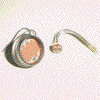|
|
BEAM From the Ground Up is a BEAM Reference Library site.
Basics of passive components --
resistors
Fighting the current
Resistance is measured in Ohms, represented by the Greek symbol Omega (W). To abbreviate a bit, prefixes are generally used to indicate a multiplier on resistance value. You will typically see just two of these:
K = thousand -- 1 KW = 1000 WM = million -- 1MW = 1,000,000 W = 1000 KW
Note that more details on unit prefixes are available in a Starting Block article here. Sometimes, to shorten things even further, people will drop the "W" entirely (so "1 KW" would become "1 K", etc.). A few get even more cryptic and use the prefix as punctuation -- so in this scheme, 4.7 KW would be written as "4K7".
Variable resistors
(potentiometers) 
Variable resistors have a dial, knob, or screw that allows you to change their resistance. The value of a variable resistor is given as it's highest resistance value. For example, a 500 ohm variable resistor can have a resistance of anywhere between 0 ohms and 500 ohms. A variable resistor may also be called a potentiometer (pot for short).
Photoresistors, as their name suggests, are resistors whose resistance is a function of the amount of light falling on them. Their resistance is very high when no light is present (up to millions of Ohms), and significantly lower when they are illuminated (hundreds of Ohms). These are also often called Light-dependent Resistors (LDRs) and Cadmium-Sulfide (CDS) cells.
Markings
Resistors are marked with their resistance values in some
more-or-less cryptic fashion. Most resistors are marked with
color codes; surface mount resistors have their own, unique
marking scheme.
BEAM Usage
I have a writeup on resistor usage in BEAMbots
here;
this includes more details on resistor markings.
|
|
|
Meanwhile, SatCure has a resistor tutorial here. |
|
|
||
|
|
This page was last updated on |
|


